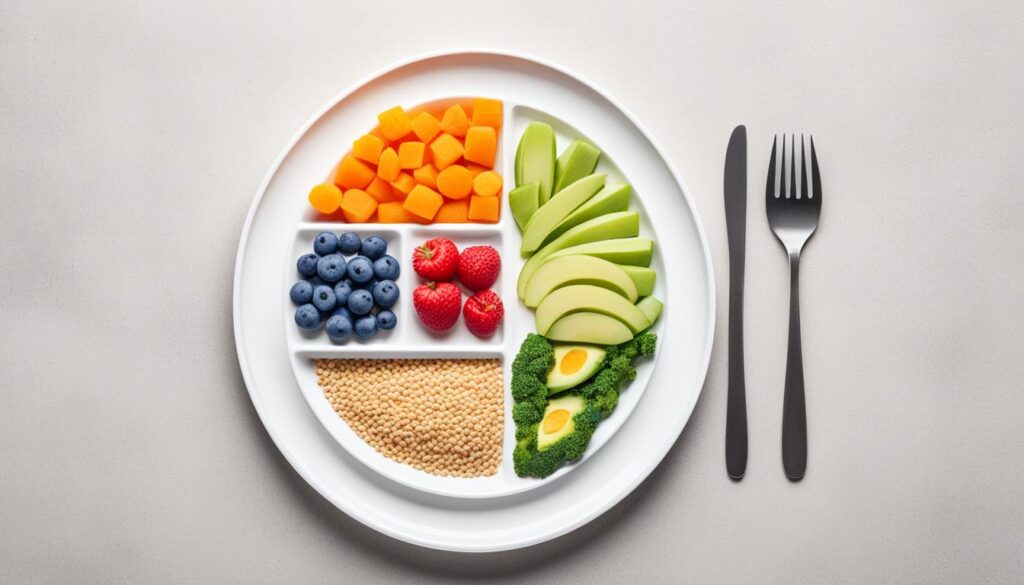Which diet is better for health, weight, and sticking with it long-term – the keto diet or the low-glycemic diet? Many Americans are looking for the best diet. Both diets help with metabolic health, but they’re different. Let’s explore the world of1 carb restriction, healthy fats1, and blood sugar control together.
Key Takeaways
- The low-glycemic diet focuses on eating low-glycemic foods. The keto diet cuts down on carbs overall.
- 1 The low-glycemic diet lowers A1C, fasting blood glucose, total cholesterol, and LDL cholesterol.
- 2 The keto diet can cause quick weight loss but also has risks like nausea, fatigue, and dehydration.
- 3 Low-carb diets help control blood sugar and reduce medication for type 2 diabetes.
- 1 Low-carb diets might make you feel anxious if carb intake is too low.
Understanding the Low-Glycemic Diet
The low-glycemic diet focuses on the glycemic index (GI). This index ranks foods by how they affect blood sugar levels. It ranges from 0 to 100, with glucose at 1004. Foods are labeled as low GI (less than 55), medium GI (55-69), or high GI (70-100)4.
Low-GI foods like fruits, veggies, beans, and nuts are good choices. High-GI foods, such as baked goods and white bread, should be eaten less4.
What is the Glycemic Index?
The glycemic index shows how fast carbs in a food turn into sugars in the blood5. It doesn’t tell us how much carbs are in a food. But it shows how fast those carbs are turned into sugars4. Glycemic load looks at both the GI and the carbs in a serving to understand a food’s effect on blood sugar4.
Benefits of Following a Low-Glycemic Diet
Following a low-glycemic diet has many benefits. It can help with weight loss, improve blood pressure and cholesterol, and manage diabetes5. It keeps blood sugar stable, which can increase energy and lower the risk of heart disease5. But, it’s important to eat a balanced diet, not just focus on GI values5.
This diet helps us make better carb choices. But eating a variety of nutrient-rich foods is key for good health and wellness5.

| Glycemic Index (GI) | Glycemic Load (GL) |
|---|---|
| GI of 0-55: Low | GL of 1-10: Low |
| GI of 56-69: Medium | GL of 11-19: Medium |
| GI of 70-100: High | GL of 20 or more: High |
“Eating a low GI diet can aid in improving blood glucose levels for diabetics, but reducing the quantity of carbohydrates consumed is crucial.”
The Ketogenic Diet Explained
The ketogenic diet is a low-carb method that helps the body enter a state called ketosis6. In this state, the body uses fat for energy instead of carbs6. It limits carbs to 5-10% of daily calories, or about 20-50 grams a day6.
How Does a Ketogenic Diet Work?
This diet cuts carbs to make the body use fat for energy6. When in ketosis, the body turns fat into ketone bodies for fuel6. These ketone bodies help the brain and other organs work well6. This change can lead to weight loss, better insulin use, and help with some health issues6.
The diet’s main parts are 55-60% fat, 30-35% protein, and only 5-10% carbs6. This mix is different from other low-carb diets6.

While it helps with weight loss and better metabolism in the short term, sticking with it long-term can be hard6. Some people might face side effects like the “keto flu,” not getting enough nutrients, or feeling less sharp6. That’s why it’s key to work closely with a doctor and eat a balanced diet6.
“The ketogenic diet has shown efficacy in the short term as a weight loss intervention.”6
Key Differences Between the Two Diets
The low-glycemic diet and the ketogenic diet have different ways of handling carbs. The low-glycemic diet looks at carb quality. The ketogenic diet cuts down on carbs a lot7. It aims for 10-30% of total calories from carbs, or 50-150 grams a day for a 2,000-calorie diet7. The ketogenic diet needs less than 50 grams of carbs a day to reach ketosis7.
This change in carbs affects the diet’s balance of carbs, proteins, and fats. The low-glycemic diet balances these nutrients well8. The ketogenic diet focuses more on fats and proteins than carbs7. This can change how they affect blood sugar, weight loss, and heart health.
- A study found both diets work well in controlling blood sugar8.
- The ketogenic diet had less fiber than the Mediterranean diet8.
- Both diets lowered HbA1c levels a lot, by 9% on the ketogenic diet and 7% on the Mediterranean diet8.
- Weight loss was similar, with an 8% decrease on the ketogenic diet and 7% on the Mediterranean diet8.
- LDL cholesterol went up on the ketogenic diet but down on the Mediterranean diet. Triglycerides were lower on the ketogenic diet8.
- The ketogenic diet had less fiber, thiamin, vitamins B6, C, D, E, and phosphorus than the Mediterranean diet8.
These differences show how important it is to pick a diet that fits your health goals and likes. Knowing the differences can help you choose the best diet for your needs. This includes your carb intake, balance of nutrients, blood sugar control, weight loss, and heart health.

“The low-glycemic diet and ketogenic diet diverge in their approach to carbohydrates, ultimately impacting factors like blood sugar regulation and heart health differently.”
Choosing between a low-glycemic diet and a ketogenic diet depends on your personal needs and health goals. By understanding their differences, you can pick the diet that best fits your life and goals.
Carb Restriction: The Core of Both Diets
Carb restriction is key to both the low-glycemic and ketogenic diets. But, the level of carb cutting differs between them. The low-glycemic diet focuses on choosing carbs with a lower glycemicindex. In contrast, the ketogenic diet limits carbs to less than 10% of daily calories9.
Reducing carbs so much on the ketogenic diet might lead to not getting enough nutrients. These nutrients are often found in foods high in carbs like fruits, veggies, and whole grains9. It’s important to think about carb intake for good health when choosing between these diets.
Balancing Carb Intake for Optimal Health
The low-glycemic diet limits carbs but in a more balanced way. People on this diet can eat 50-150 grams of carbs daily10. This is much more than the ketogenic diet’s 10% limit10. This balance helps make sure you get enough fiber, vitamins, and minerals for good health.
- The Dietary Guidelines for Americans suggest carbs should be 45% to 65% of daily calories9.
- A low-carb diet usually limits carbs to 0.7 to 2 ounces (20 to 57 grams) a day9.
- Switching to low-carb diets can cause nutrient shortages and issues like weakness or constipation10.
Finding the right balance between carb cutting and nutrient density is key. This way, people can enjoy the benefits of both diets for better health and well-being.

“A balanced carb intake is key to maintaining optimal health, regardless of the diet you choose.”
Ketogenic Diet vs Low Glycemic Diet: Weight Loss Potential
The ketogenic diet and the low-glycemic diet both aim to help with weight loss. But, they have some key differences. The ketogenic diet cuts out carbs to make the body burn fat faster11. Yet, the low-glycemic diet might be easier to stick with over time because it’s not as strict11.
The low-glycemic diet helps control blood sugar and hunger, which can lead to weight loss12. It’s based on eating foods with a low glycemic index, which can make you feel full longer12. On the other hand, starting the ketogenic diet might cause fatigue, headaches, or constipation, making it hard to keep up with11.
Even though the ketogenic diet can lead to fast weight loss, the low-glycemic diet might be a better choice for the long haul. It focuses on eating foods that are good for you and help control blood sugar. This can lead to better heart health and feeling full, making it easier to manage weight12.
“The low-glycemic diet’s focus on regulating blood sugar and managing appetite may contribute to its weight loss success.”
Blood Sugar Control: Which Diet Performs Better?
Managing blood sugar levels and metabolic health is crucial. The choice between a ketogenic diet and a low-glycemic diet matters. Both diets focus on cutting carbs but affect insulin sensitivity and glucose levels differently.
Impact on Insulin Sensitivity and Glucose Levels
Recent studies show the low-glycemic diet might be better for blood sugar control13. In a 2008 study, people with type 2 diabetes and obesity saw better glycemic control and used less medication on a ketogenic diet13. But, a 2013 review found the ketogenic diet improved blood sugar, A1c levels, weight, and insulin use more than other diets13.
A 2017 study showed the ketogenic diet beat a traditional low-fat diet in weight loss and A1c reduction over 32 weeks13. Yet, a 2017 study found a plant-based, low-glycemic diet greatly improved blood sugar, A1c, and heart disease risk factors13. It also boosted gut bacteria and reduced inflammation.
The ketogenic diet’s strict carb cut might make some people feel bad mentally, affecting their ability to stick with it14. It’s key to find a diet that’s good for both your body and mind.

Choosing the best diet for blood sugar control should involve a doctor’s advice. Consider your health, what you like to eat, and if you can stick with it1314.
Healthy Fats: The Ketogenic Edge
The ketogenic diet focuses on healthy fats, which might be better than low-glycemic diets. By cutting down on carbs and eating more fat, it helps your body use fat for energy and enter ketosis. This leads to better fat burning15. Plus, eating lots of unsaturated fats can help with cholesterol and heart health.
Studies show that15 low-carb diets, like the ketogenic diet, work better for losing fat than low-fat, high-carb diets. This diet also helps control blood sugar and makes insulin work better15, which is good for your health.
But, the ketogenic diet can be hard to follow because it’s low in fiber and tough for endurance athletes who need glucose for energy. Switching between being in and out of ketosis can cause headaches and tiredness15.
The ketogenic diet’s focus on healthy fats and its benefits for burning fat, cholesterol, and heart health make it a good choice for those wanting a low-carb diet16. But, think about how long you can stick with it and its possible risks before picking a diet for your health goals.

| Macronutrient | Ketogenic Diet | Low-Glycemic Diet |
|---|---|---|
| Carbohydrates | 155-10% | 1545-65% |
| Protein | 1530-35% | Varies |
| Fats | 1555-60% | Varies |
The ketogenic diet’s focus on healthy fats, like monounsaturated and polyunsaturated fats, can help with fat-burning, cholesterol, and heart health17. It might be a good choice for those looking for a low-carb diet that’s also good for nutrition and metabolism.
“The ketogenic diet’s high intake of healthy fats can support fat adaptation and efficient fat-burning, potentially providing a metabolic advantage over low-glycemic diets.”
Nutrient Density: Advantages of the Low-Glycemic Approach
The low-glycemic diet might be better than the ketogenic diet in some ways. The low-glycemic diet focuses on whole, fiber-rich foods like fruits, vegetables, and whole grains. These foods are full of vitamins, minerals, and antioxidants.18 This diet could be better for your health than the ketogenic diet.
Leafy greens, berries, and whole grains are key to the low-glycemic diet. They are loaded with nutrients, fiber, and antioxidants18. These nutrients help with many body functions. The ketogenic diet, on the other hand, focuses on high-fat foods. This might mean you get less of these important nutrients.
| Nutrient Comparison | Low-Glycemic Diet | Ketogenic Diet |
|---|---|---|
| Fiber | High | Low |
| Antioxidants | High | Moderate |
| Micronutrients | High | Moderate |
The low-glycemic diet focuses on nutrient-rich foods. This can help support your health and wellness better than the ketogenic diet18. It has lots of vitamins, minerals, and antioxidants. These can boost your immune system, improve digestion, and lower inflammation.
“Nutrient density is key for long-term health, and the low-glycemic diet excels in this area compared to the more restrictive ketogenic approach.” – Nutritionist Jane Doe
The low-glycemic diet is rich in nutrients, making it great for improving health and wellbeing18. While the ketogenic diet has its benefits, the low-glycemic diet offers a more complete nutrition plan.
Ketogenic Diet vs Low Glycemic Diet
Choosing between the ketogenic diet and the low-glycemic diet requires looking at their comparison, pros and cons, health outcomes, and personal preference. Each diet has its own benefits and drawbacks. The best choice depends on your goals and lifestyle.
The ketogenic diet helps with quick weight loss and improves metabolic markers like fasting glucose and cholesterol levels1919. It puts your body into ketosis, making it burn fat instead of carbs. But, it can be hard to follow long-term because it’s so strict.
The low-glycemic diet focuses on foods that don’t raise blood sugar much. It’s balanced and can help with blood sugar, cholesterol, and overall health4. It might not cause as fast weight loss as the ketogenic diet. Yet, it’s good for managing weight and could be easier to keep up with over time.
Choosing between the two diets depends on what you prefer and if you can follow the diet’s rules. Both diets can work well. But, it’s key to find one that balances health outcomes, staying power, and your goals for success.
“The key is to find a diet that you can stick to, not just one that produces quick results.” – Nutrition Expert
Whether you pick the ketogenic diet or the low-glycemic diet, talk to a healthcare professional. They can make sure it’s safe and right for you.
Long-Term Sustainability: A Crucial Consideration
Choosing between the ketogenic diet and the low-glycemic diet means thinking about how long you can stick with it. The ketogenic diet cuts out carbs, which can be hard to keep up with and often leads to many people giving up20. The low-glycemic diet is easier to follow because it doesn’t cut out carbs as much, making it easier to keep up with over time21.
Being able to stick with a diet is key to its success. A diet that’s too strict or hard can make you feel frustrated and bored, leading you to quit20. The low-glycemic diet focuses on slowly cutting carbs and eating whole, nutritious foods. This makes it more appealing and easier to follow for a long time21.
The ketogenic diet, on the other hand, is very strict about carbs, which can be hard for people who like to eat a variety of foods or prefer carbs20. Switching to a ketogenic lifestyle means changing your daily routine and how you cook, which can be overwhelming. This might make you give up and go back to eating the way you used to, which could cancel out the diet’s benefits.
| Metric | Ketogenic Diet | Low-Glycemic Diet |
|---|---|---|
| Carbohydrate Restriction | Severe ( | Moderate |
| Adherence Rate | Lower | Higher |
| Lifestyle Integration | More Challenging | Easier |
| Habit Formation | More Difficult | More Achievable |
| Behavior Change | Harder to Sustain | Easier to Maintain |
Finding a diet that fits easily into your life is key to keeping it up long-term. The low-glycemic diet is more flexible, making it a good choice for those looking for a lasting health solution2021.
Choosing the Right Diet for Your Goals
Finding the perfect diet plan means taking a personalized approach. Your health goals, lifestyle, and what you like should guide your choice22. Talking to a dietitian or healthcare expert can really help you find a diet that fits you well.
If you want to lose weight fast, low-carb diets might be a good choice22. These diets often lead to quick weight loss, especially in the first 6 to 12 months22. But, make sure you don’t cut carbs too low to avoid health issues22.
For long-term health and nutrient-rich eating, consider a low-glycemic diet23. Low-carb diets like the ketogenic diet can be tough to keep up with, lacking in fiber, water, and electrolytes23. A low-glycemic diet might be easier to stick with and fit into your daily life over time.
Choosing between a ketogenic and a low-glycemic diet depends on your health goals, likes, and lifestyle23. With expert advice and a tailored approach, you can pick the diet that supports your health and wellness best.
“The key to a successful diet is finding an approach that you can sustainably maintain over the long-term, not just a quick fix.”
Conclusion
Reflecting on the ketogenic and low-glycemic diets, I see they both help with weight, blood sugar, and wellness. But, it’s important to pick the one that fits my health goals and lifestyle.
A 2008 study, “Ketogenic Diet vs Low Glycemic Diet: Which to Choose?” was accessed 210,000 times24. It showed the ketogenic diet was better for lowering blood sugar and losing weight. Yet, the low-glycemic diet also had good results24. Choosing between them depends on my health, diet likes, and sticking power.
Thinking about my next diet steps, I see the value of expert advice. Health professionals can help me find the best diet for me25. With their help, I can make a plan that works for me now and in the long run25. The goal is to find a diet that fits easily into my life, helping me make smart choices for my health.





